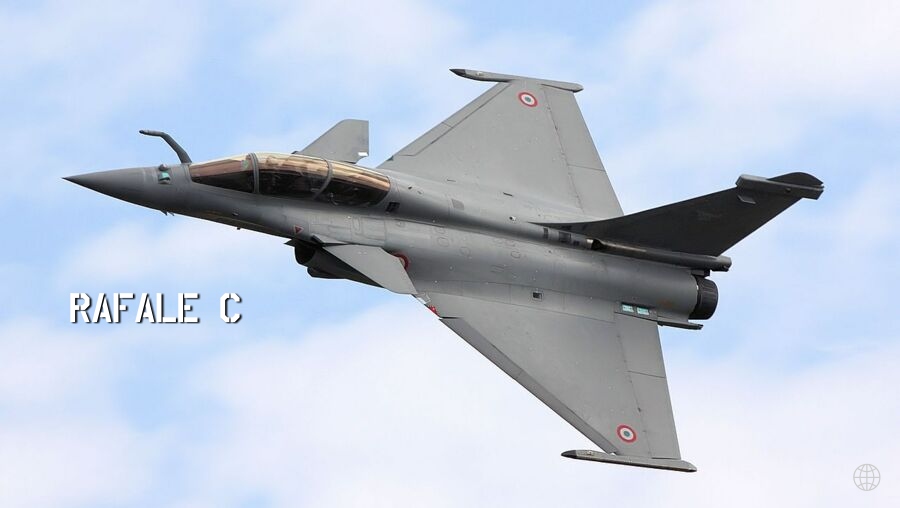RAFALE MULTI-ROLE FIGHTER, FRANCE

Rafale is a twin-jet combat aircraft capable of carrying out a wide range of short- and long-range missions, including ground and sea attack, air defence and air superiority, reconnaissance, and high-accuracy strike or nuclear strike deterrence.
The aircraft has been developed for the French Air Force and Navy. 61 aircraft were ordered (36 for the Air Force and 25 for the Navy) and in September 2004, a further 59 aircraft (11 two-seater and 36 single-seat for the Air Force and 12 Rafale M for the Navy, delivery 2008 to 2012) out of a total requirement of around 300 (234 for the Air Force and 60 for the Navy). The Rafale is produced in three variants - M, B and C. The Rafale M variant is a single-seater carrier-based version for the navy, while B and C are two-seat and single-seat versions respectively for the Air Force. The Rafale M entered service in 2001 and ten have been delivered. Seven aircraft are operational on the Charles de Gaulle aircraft carrier. Four Rafale B aircraft and one Rafale C have been delivered to the Air Force. Rafale B and C will enter service with the RAF in 2006.
Rafale fighters delivered to the Navy so far are F1 standard with air-to-air capability. F2 standard with air-to-ground missiles will begin an initial testing phase at Mont-de-Marsan military flight test center from September 2004. A contract to develop the fully capable F3 standard aircraft with Thales terrain-following RBE2 3D radar, Thales RECO NG optronics pod and the capability to launch ASMP-A nuclear missiles and AM39 Exocet anti-ship missiles was signed in February 2004. An order for 59 F3 aircraft, 47 for the Air Force (11 two-seat and 36 single-seat) and 12 (single-seat) for the Navy, was placed in December 2004. The Rafale F3 will be delivered from 2007 and the first squadron of 20 aircraft will be in service in 2008.
COCKPIT
The cockpit has hands-on throttle and stick control (HOTAS). The cockpit
is equipped with a head-up, wide-angle holographic display from Thales
Avionique, which provides aircraft control data, mission data and firing
cues. A collimated, multi-image head-level display presents tactical
situation and sensor data, and two touch-screen lateral displays show
the aircraft system parameters and mission data. The pilot also has
a helmet-mounted sight and display. A CCD camera and on-board recorder
records the image of the head-up display throughout the mission.
WEAPONS
The Rafale can carry payloads of over nine tons on 14 hardpoints for
the Air Force version, and 13 for the naval version. The range of weapons
includes: Mica, Magic, Sidewinder, ASRAAM and AMRAAM air-to-air missiles;
Apache, AS30L, ALARM, HARM, Maverick and PGM100 air-to-ground missiles;
and Exocet/AM39, Penguin 3 and Harpoon anti-ship missiles. For a strategic
mission the Rafale can deliver the MBDA (formerly Aerospatiale) ASMP
standoff nuclear missile. In December 2004, the MBDA Storm Shadow /
Scalp EG stand-off cruise missile was qualified on the Rafale.
From 2006, the Rafale will also be armed with the Sagem AASM precision-guided bomb, which has both GPS / inertial guidance and, optionally, imaging infrared terminal guidance.
The Rafale has a twin-gun pod and a GIAT 30mm DEFA 791B cannon which can fire 2,500 rounds per minute.
The Rafale is equipped with laser designation pods for laser guidance of air-to-ground missiles.
COUNTERMEASURES
The Rafale's electronic warfare system is the Spectra from Thales. Spectra
incorporates solid state transmitter technology, radar warner, DAL laser
warning receiver, missile warning, detection systems and jammers.
SENSORS
The Rafale is equipped with an RBE2 radar, developed by Thales, which
has look-down and shoot-down capability. The radar can track up to eight
targets simultaneously and provides threat identification and prioritisation.
The optronic systems include the Thales/SAGEM OSF infrared search and track system, installed in the nose of the aircraft. The optronic suite carries out search, target identification, telemetry and automatic target discrimination and tracking.
NAVIGATION
AND COMMUNICATIONS
The communications suite on the Rafale uses the Saturn onboard V/UHF
radio, which is a second-generation, anti-jam tactical UHF radio for
NATO. Saturn provides voice encryption in fast-frequency hopping mode.
The aircraft is also equipped with fixed-frequency VHF/UHF radio for
communications with civil air traffic control. A multifunction information
distribution system (MIDS) terminal provides secure, high-data-rate
tactical data exchange with NATO C2 stations, AWACS aircraft or naval
ships.
Rafale is equipped with a Thales TLS 2000 navigation receiver, which is used for the approach phase of flight. The TLS 2000 integrates the instrument landing system (ILS), microwave landing system (MLS) and VHF Omni-directional Radio-ranger (VOR) and marker functions.
The radar altimeter is the AHV 17 altimeter from Thales, which is suitable for very low flight. The Rafale has a TACAN tactical air navigation receiver for en route navigation and as a landing aid.
The Rafale has an SB25A combined interrogator-transponder developed by Thales. The SB25A is the first IFF using electronic scanning technology.
ENGINE
The Rafale is powered by two M88-2 engines from SNECMA, each providing
a thrust of 75kN. The aircraft is equipped for buddy-buddy refuelling
with a flight refuelling hose reel and drogue pack.
Messier-Dowty provides the "jumper" landing gear, designed to spring out when the aircraft is catapulted by the nose gear strut.